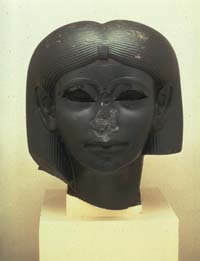Exhibition Reviews
| Home | | Museum Guide | | International | | Theater |
Egypt Reborn at Brooklyn Museum of Art
"Egypt Reborn: Art for Eternity"
Brooklyn Museum of Art, 200 Eastern Parkway, Brooklyn
718-638-5000
Museum Admission by Contribution: $6, students with valid I.D. and older adults
$3, children under 12 free.
Opened April 12, 2003
By Paulanne Simmons
 |
| Head of Queen from Mid-Dynasty XII, ca. 1876-1842 B.C. |
In any other city, the Brooklyn Museum of Art, housed in its magnificent McKim, Mead and White beaux-arts masterpiece, would be a major cultural institution. But in New York City, just a subway ride from the heart of Manhattan, its splendid halls are mostly quiet and half-empty, save on popular "First Saturday" evenings or when an exhibit attracts the attention of a disgruntled mayor. Yet this museum happens to hold one of the finest Egyptian art collections in the United States.
In 1993, more than 500 ancient Egyptian treasures were placed on display in the newly renovated Morris A. and Meyer Schapiro Wing. That installation begins with a chronological presentation of material dating from the Amarna Period and the reign of Amunhotep IV, later known as Akhenaten, and his wife Nefertiti, through the Ptolemaic and Roman Periods. The final galleries of the 1993 installation contain a thematic presentation entitled "Temples, Tombs, and the Egyptian Universe," which explores the connection between ancient Egyptian religious beliefs and art.
This April, the museum added to the original exhibition more than 600 objects from its ancient Egyptian holdings. These objects, three-quarters of which have not been on view for at least a decade, comprise "Egypt Reborn: Art for Eternity," presented in newly renovated gallery space.
The new installation begins with "Permanence and Change," a thematic section, organized around four topics: Early life along the Nile, Life & Belief, Art & Communication, and Materials & Technology. This section focuses not so much on great works like the pyramids or the sphinx, but rather works of art linked to all aspects of Egyptian life and belief.
A wood and ivory chair from 1400 - 1294 B.C., looks like an antique one might find in the home of a wealthy contemporary connoisseur. A senet board and playing pieces are presented not only as a game played for 3,000 years but as a representation of how Egyptians believed their souls traveled.
One of the key premises of this section is that the Egyptians had no word for art and no belief in art for its own sake. The objects made by Egyptian artists and artisans were meant to be used - whether for religious or utilitarian purposes. This meant that statues, reliefs and paintings all followed formal rules - the same rules that were applied to the creation of pottery, utensils and jewelry - which are given ample attention in his exhibition, as well.
Happily, this gallery also contains the doors that originally served as the museum's main entrance before the removal of the front staircase in 1934. The doors, which lead out on to a small balcony, will give visitors an excellent view of the new front entrance and plaza area when it is completed.
The Permanence and Change section is followed by a chronological presentation that ranges from the Predynastic Period through the 18th Dynasty reign of Amunhotep III.
From the Old Kingdom, comes a limestone group statue of a scribe of the granary and his wife and small son. The first major work of Egyptian art ever exhibited in America, this group shows how Egyptians subordinated actual size and proportion to cultural and spiritual needs: The young son, who is shown sucking a finger, is the same size as his mother, and if the seated scribe were standing, he would tower over both.
The Head of a Queen from the Middle Kingdom would have a remarkably modern look - if not for the missing nose and obvious repairs to the eyes, lips and chin.
The simple, rectangular coffin of one of Mantuhopet II's wives, who died at the age of six and was buried in his funerary temple, shows the kind of burial people of lesser standing than pharaohs could expect.
The exhibition, which includes wheelchair-accessible interactive kiosks with touch screens, and is accompanied by "Egypt through Other Eyes," an exhibition of more than 30 books selected from the holdings of the museum's Wilbur Library of Egyptology, is nothing if not meticulous and extensive. For many, it may prove overwhelming. But fortunately, Egypt Reborn: Art for Eternity is a long-term installation - which means visitors to the museum will have ample time to return again and again to savor the sights and absorb the ideas presented in his remarkable exhibition.[PS]